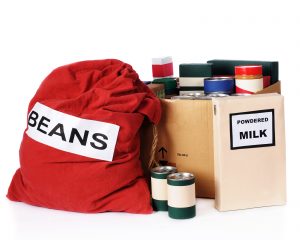
Are you prepared to feed your family if a disaster were to strike? (photo credit: BigStockPhoto.com)
September is National Preparedness Month which is a great opportunity to talk about what you can do to make sure your family is prepared for emergencies and unexpected events. Here in Arizona, we don’t have to worry about the kinds of natural disasters that affect other parts of the country like hurricanes or ice storms but that doesn’t mean we don’t need to be prepared. According to the Arizona Emergency Information Network (AZEIN), all residents need to be prepared for natural disasters like floods, monsoons, tornados, earthquakes, and extreme heat events, as well as other types of disasters like chemical, biological, and radiological events.
Preparedness is every citizen’s responsibility and when it comes to being ready, one of the most important things you need to think about is food. If you think back on recent disasters like Hurricane Katrina, Superstorm Sandy, and the current ongoing flash floods affecting large parts of Colorado, one thing that frequently happens is that people are cut off from services for days and may have service disruption for weeks after the event. This often means no power and no access to grocery stores or restaurants which means one of the most important preparedness questions you need to ask yourself is this:
If you had to feed yourself and your family for several weeks with no refrigerator, no stove, and without leaving your house, could you do it?
This underlies the importance of having some long term food storage as part of your overall preparedness plan. Just in Case Arizona in line with the Federal Emergency Management Agency (FEMA) recommends having supplies on hand that would allow your family to shelter in place for a minimum of three days. When it comes to food, that means non-perishable food items that will meet the dietary needs of your family members. At a glance, most of us would feel certain that we have at least three days worth of the food in the house. However, if you think it all the way through, you may realize that although you have more than enough food for three days, the food you have may not be the food you need when disaster strikes. AZEIN recommends using the following guidelines when creating your emergency food plan.
- Plan for at least 3 days of non-perishable food.
- Remember that even non-perishable items, like macaroni and cheese, can require perishable items in order to make them edible. It is important to remember this when determining which foods you will keep on hand for your emergency plan.
- Make sure the foods you choose require little to no preparation and can be cooked or prepared with little to no water. This is important since potable water may also be in very short supply during an emergency.
- Pick things your family will eat.
- Avoid food items that are high in salt.
- Recommended food items include:
- Ready to eat canned foods including meats, fruits, vegetables
- Dry cereal
- Peanut butter
- Crackers
- Nuts
- Protein or energy bars
- Dried fruit
- Can juice
- Dehydrated milk
- Don’t forget to plan for any special dietary needs. If you have infants or family members with allergies or who need to follow special dietary restrictions, you will need to include special food items for those people in your plan.
Related articles
- Prevent Kitchen Fires: 5 Simple Tips (fillyourplate.org)
- No Farmers, No Food (fillyourplate.org)
- Fire it Up! Grilling Safety Tips (fillyourplate.org)

